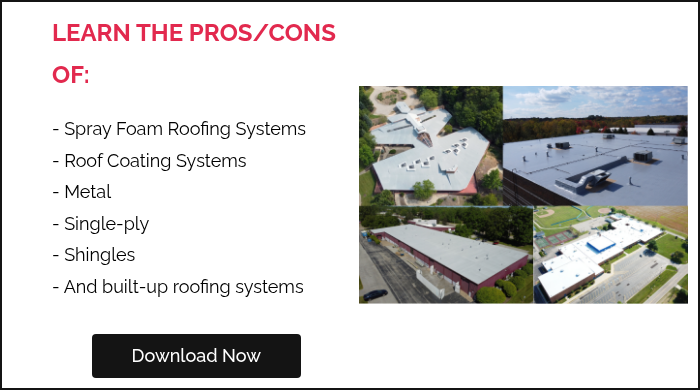As weather changes from season to season, it’s important to keep up with your maintenance plan to keep your roof in working order. With weather changes, roof blisters may appear on your commercial flat roof. While roof blisters may not need immediate attention, if left unmonitored, they could lead to saturated insulation and a damaged membrane.
Roof blisters are not limited to one type of roof system; they appear in all types of roofing systems – residential and commercial. Roof systems with membranes are more prone to blistering because blisters are formed by gaps between the membrane plies or between the underlying substrate and the membrane.
What is a Roof Blister?
A roof blister is a raised area where there is a loss of adhesion of the roof. This area can fill up with air or water to form a blister – which looks like a bubble on your roof. If left untreated, a blister can grow larger and allow more moisture to get in so that the problem gets worse until more extensive repairs and possible replacement is necessary…unless it pops!

Roof blisters can be caused by any number of problems:
- Moisture
- Poor Installation
- Poor Ventilation
This article will cover the main causes of commercial roof blisters and how they are repaired.
When air or water is trapped in a blister, the weather can cause the blister to grow on a daily basis. Warm weather will cause the water or air to expand during the day. The cool temperature will cause the trapped water or air to contract at night.
How to Prevent Roof Blisters
Keep Dry
The number one rule for preventing commercial roof blisters is to use dry materials in dry settings. If your contractor says they need more time for the right weather or for your facility roof to dry out after bad weather, ensure they get that time. Here are some tips to be sure your roof and materials stay dry:
- Seal any substrate materials
- Store roofing materials inside or well-sealed with tarps
- Verify the substrate is dry after harsh weather or cleaning before the new roof is installed

Proper Installation
Another blister prevention tip is to make sure your materials have firm contact between them for the adhesion to work properly.
- Install the insulation board snugly to substrate
- Clean the work area of dust and other contaminants
- Allow proper ventilation for the new roof system
While as a facility owner or manager, you may not have control over the installation process of your contractor. You can ensure you hire the right contractor and talk to them about installing your roof to the manufacturer’s specifications.
Regular Inspections
Whether you have a new roof or your roof is a few years old, it’s important to have a maintenance contract with a local roofing contractor. A maintenance contract will ensure your roof is regularly inspected, and any damage will be addressed before it causes major damage to your substrate or facility.
How to Fix Roof Blisters

Generally speaking, roof blisters that contain air are still keeping water out of the substrate. Unless the roof blister falls under this list of characteristics (from roofingcontractor.com), you may be fine with leaving your blisters alone:
- Loss of gravel, granules, or another surfacing
- Membrane deterioration
- Blisters in seams that have reduced lap coverage
- Blisters that have breaks that can admit moisture
- Blisters that have fatigue cracking around the circumference
- Blisters that occur in areas of high traffic
If your blister needs to be repaired, it’s best to hire a contractor to perform the repair properly. If your roof is still under warranty, call the contractor that installed your roof to see what they can do to help you.
There are a few ways a contractor will repair a blister:
- Membrane roof – Cut away the membrane that has lost adhesion, replace any wet insulation with like material, and replace the membrane with overlapping edges at least 6 inches wide.
- Bitumen roof – If the membrane is in good condition, your contractor can simply cut an X shape into the blister to access the layer underneath. If the membrane is damaged, your contractor will need to replace the entire damaged area.
Investing in a commercial roofing project can be a daunting task. But by being prepared and asking the right questions, you can find the right contractor to deliver high-quality work for a good price.
Next Steps? Learn more about commercial roofing!
In our free guide, you’ll learn common questions about commercial roofing, such as:
- What is a spray foam roof?
- What is a single-ply membrane roof?
- What is a built-up roof?
- What are the characteristics of a metal commercial roof?


